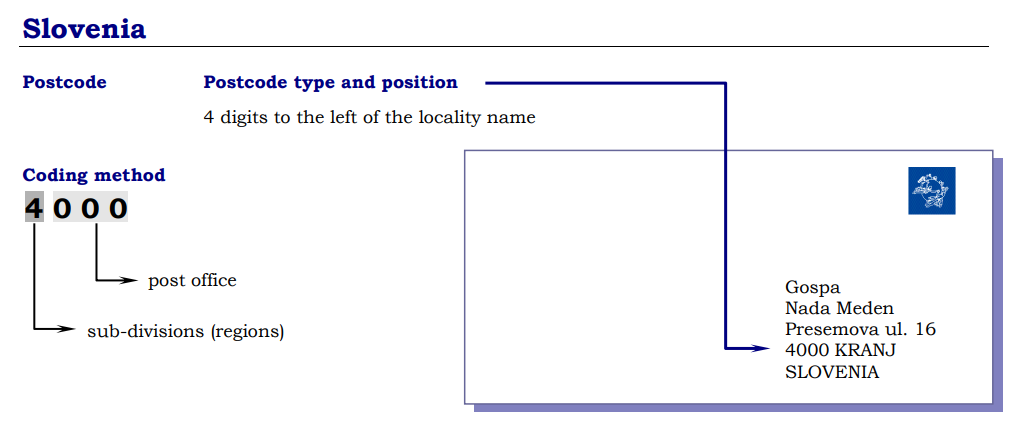Slovenia Zip Code
Slovenia Postal code
Slovenia is a country located in the middle of Europe, bordering with Italy, Austria, Hungary, and Croatia. The capital of Slovenia, Ljubljana, is located in the center of the country and represents at the same time the largest city in the country. Since independence in 1991, the country has been considered a sovereign state, accepted by the UNO in 1992 and by the EU in 2004. The history of the nation is very varied: under the rule of the Romans, the country became a duchy, then moved to the empire Hapsburg and became part of the Austro-Hungarian kingdom. With the fall of the empire, Slovenia was assigned to the Yugoslav kingdom and became a member of Socialist Yugoslavia after the Second World War. Only after the ten-day War in 1991, Slovenia gained independence. Today, the country has about 2 million inhabitants, consisting of Slovenes, Bosnians, Serbs, and Croats. In Slovenia, there is also a small community of Germans too, but they are not recognized as ethnic minorities. The official language is Slovene, in hybrid parts in the ethnic sense. Italian and Hungarian languages have a certain protection.
Highly articulated
Instead of talking about regions or provinces, Slovenia is subdivided into 212 municipalities, including eleven municipal communities. These central municipal communities are: Celje, Koper, Kranj, Ljubljana, Maribor, Murska Sobota, Nova Gorica, Novo Mesto, Ptuj, Slovenj Gradec and Velenje. Between the municipal level and the state level in Slovenia there is no other subdivision, although there have been aspirations in this direction: in 2008 a popular referendum asked for the country to be resettled in provinces, however, not generating much interest among the population. There are, however, so-called statistical regions, 12 in Slovenia, but at administrative level they have no direct value. This subdivision dates to historically rooted traditional regions, which perhaps will have a more important administrative role in the upcoming future. The statistical regions of Slovenia are: Gorenjska region (Alta Carniola), Goriška region (Gorizia), South Slovenia region (Slovenia Southeast), Carinthia region (Carinthia), Primorje-notranjska region (Carniola Interna-Carso, until 2014: Notranjsko- The Karst region), the Coastal Region (Litoral-Carso), the Osrednjeslovenska region (Slovenia Centrale), the Podravska region (Oltredrava), Pomurska region (Murania), Savinjska region, Posavina region (Oltresava Inferiore, up to 2014: Zasavska regija.
Post system in Slovenia
Slovene Post Office, the country post is called "Pošta Slovenije" or shortly "PS". It is responsible for the postal service and uses the four-post postal code, which was introduced after the independence in 1991. Firstly, codes were used in five positions, which were valid for the whole of Yugoslavia. Today's ZIP codes in Slovenia are made up of four digits: while the first digit (in some cases the first two digits) is also reflected in the postal regions. The last three digits refer to the postal districts of urban or rural areas. The urban zones, with only a few exceptions, for their ZIP codes are using as final digits "x000", which is the identifier for the municipal municipalities. Of various municipal municipalities these are:
Celje: 3000
Koper: 6000
Kranj: 4000
Ljubljana: 1000
Maribor: 2000
Murska Sobota: 9000
Nova Gorica: 5000
New place: 8000
Ptuj: 2250
Slovenj Gradec: 2380
Velenje: 3320
That the statistical regions do not have any administrative value till today, but still play an important role in the postal service, it can be easily seen by looking the followings ZIP codes:
Gorenjska region (Alta Carniola):
4000 for the municipality of Kranj
42xx for the remaining municipalities
Goriška region (Gorizia):
5000 for the municipality of Nova Gorica
52xx
South-eastern Slovenia region (Slovenia South-East):
13xx
8000 for the municipality of Novo Mesto
82xx
83xx
Carinthia (Carinthia)
23xx
2380 for the municipality of Slovenj Gradec
8216 for the commune of Mislinja
Primorje-Notranjska region (Carniola Intera-Carso, until 2014: Notranjsko-kraška region)
13xx
62xx
Coastal-Carp region (Litoral-Carso)
6000 for the municipality of Koper
62xx
63xx
Osrednjeslovenska regija (Slovenia Centrale)
1000 for the municipality of Ljubljana
12xx
13xx
Podravska region (Oltredrava)
2000 for the municipality of Maribor
22xx
2250 for the municipality of Putj
23xx
Pomurska regija (Muranija)
9000 for the municipality of Murks Sobota
92xx
Savinjska region
3000 for the municipality of Celje
32xx
33xx
3320 for the municipality of Velenje
Posavina Region (Oltresava Inferiore, up to 2014: Southeastern Region)
32xx
82xx
83xx
14xx
Zasavska region
14xx
12xx
Note: In Slovenia, it is customary to place the abbreviation of the country "SI" in the four-digit postal code. A dash separates the two parts, the abbreviation and the numeric code.
Gospa Borisek
Prvomajska ulica 20
9203 - Petrovci
Murska Sobota
SLOVENIA

- Toal Postal Code in Country:- Total 556 Postal Code In SloveniA
- Postal Code Type :- 4-digit
- Toal Population :- 2.1Million (May2023)
- Capital Name :-LjubljaNA
- Dialing Code :-386
